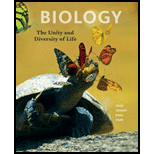
Concept explainers
Which of the following statements is not correct?
- a. Energy cannot be created or destroyed.
- b. Energy cannot change from one form to another.
- c. Energy rends to disperse spontaneously.
Introduction: “Energy cannot be created and destroyed, but it can be converted from one form to another”. It is the capacity to do work. It can tend to spread or disperse until no part of the system has more than one part.
Answer to Problem 1SQ
Correct answer:
Option b. is given as “Energy cannot change from one form to another”. The statement is incorrect.
Therefore, option b. is correct.
Explanation of Solution
Reasons for the correct answer:
Energy can be converted from one form to another. During photosynthesis, solar energy is converted to chemical energy. So, the statement “Energy cannot change from one form to another” is wrong.
Hence, option b. is correct.
Reasons for the incorrect answer:
Option a. is given as “Energy cannot be created or destroyed”. This is the first law of thermodynamics. The given statement is true.
So, option a. is incorrect answer.
Option c. is given as “Energy tends to disperse spontaneously”. This is the second law of thermodynamics. The given statement is true.
So, option c. is incorrect answer.
Hence, options a., and c. are incorrect answers.
Energy cannot change from one form to another is not the correct statement.
Want to see more full solutions like this?
Chapter 5 Solutions
Biology: The Unity and Diversity of Life (MindTap Course List)
Additional Science Textbook Solutions
Genetics: Analysis and Principles
Prescott's Microbiology
Human Biology: Concepts and Current Issues (8th Edition)
Genetics: From Genes to Genomes
Microbiology with Diseases by Taxonomy (5th Edition)
- Which of the following is not an example of an energy transformation? a. Heating up dinner in a microwave b. Solar panels a work c. Formation of static electricity d. None of the abovearrow_forwardThe flow of energy moves from...arrow_forwardDefine the following terms: a. thermodynamics b. bioenergetics c. entropy d. enthalpy e. free energyarrow_forward
- Which statement about energy is not correct? Energy is the ability to do work. A large ball on top of a hill has kinetic energy. The biological world gets its energy from the sun. Chemical bonds store potential energy. All forms of energy can be converted to heat.arrow_forwardA lawnmower uses gasoline for fuel. The lawnmower has a moving blade, makes lots of noise, and has a few lights on it. The engine of the lawnmower gets very hot. A. What kinds of energy transformations are happening in the lawnmower? B. What does the law of conversation of energy tell 6ou about the energy used by the lawnmower?arrow_forwardWhich are the several forms of energy important in biological systems.arrow_forward
- Which is established by the electron transport chain and can be used to drive cellular work especially by the ATP synthase? a. Kinetic Energy b. Electrical Energy c. Gravitational Force d. Proton-Motive Forcearrow_forwardthe energy released by ___ reactions is used to run ________ reactions A. ENDERGONIC; ENDERGONIC B. EXERGONIC; ENDERGONIC C. EXERGONIC; EXERGONIC D. ENDERGONIC; EXERGONICarrow_forwardName and describe the two forms of energy and provide an example of each.arrow_forward
- Why are the laws of thermodynamics considered laws of nature and not scientific theories? a. We have a complete scientific explanation of energy behavior. b. We understand why energy behaves the way it does but not exactly how it behaves. c. We do not understand how or why energy behaves the way it does. d. We understand how energy behaves but not exactly why it behaves the way it does. e. We cannot be absolutely sure that energy will behave the same under all conditions.arrow_forwardWater behind a dam has a certain amount of stored energy that can be released as the water falls over the top of the dam. It may be enough energy to turn a mill wheel or an electricity-generating turbine. Choose the term that best describes the type of energy stored in the water at the top of the dam. Select one: A. Kinetic B. Radiant C. Chemical D. Transformative E. Potentialarrow_forwardElectron transport is a system that transforms ____ energy into _____ energy.arrow_forward
 Biology Today and Tomorrow without Physiology (Mi...BiologyISBN:9781305117396Author:Cecie Starr, Christine Evers, Lisa StarrPublisher:Cengage Learning
Biology Today and Tomorrow without Physiology (Mi...BiologyISBN:9781305117396Author:Cecie Starr, Christine Evers, Lisa StarrPublisher:Cengage Learning
 Concepts of BiologyBiologyISBN:9781938168116Author:Samantha Fowler, Rebecca Roush, James WisePublisher:OpenStax College
Concepts of BiologyBiologyISBN:9781938168116Author:Samantha Fowler, Rebecca Roush, James WisePublisher:OpenStax College Biology (MindTap Course List)BiologyISBN:9781337392938Author:Eldra Solomon, Charles Martin, Diana W. Martin, Linda R. BergPublisher:Cengage Learning
Biology (MindTap Course List)BiologyISBN:9781337392938Author:Eldra Solomon, Charles Martin, Diana W. Martin, Linda R. BergPublisher:Cengage Learning Principles Of Radiographic Imaging: An Art And A ...Health & NutritionISBN:9781337711067Author:Richard R. Carlton, Arlene M. Adler, Vesna BalacPublisher:Cengage Learning
Principles Of Radiographic Imaging: An Art And A ...Health & NutritionISBN:9781337711067Author:Richard R. Carlton, Arlene M. Adler, Vesna BalacPublisher:Cengage Learning




